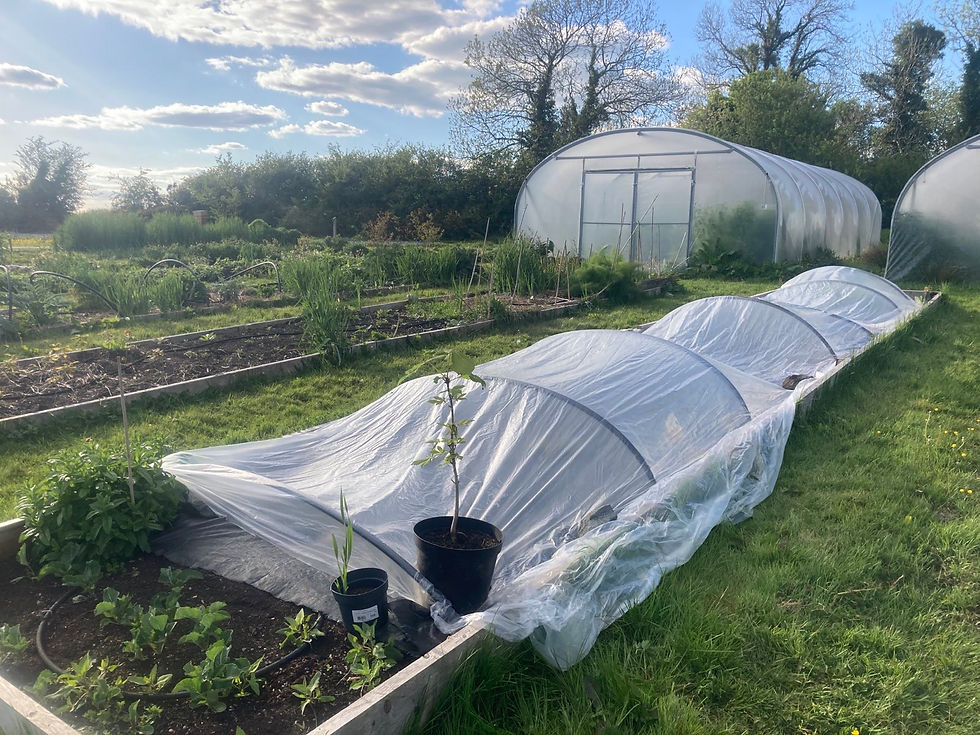18-Oct-2024: Moving Bees, Hedge Cutting, Perc Test Holes
- Stan Lanning
- Oct 18, 2024
- 4 min read
We have two hives - both captured swarms early this year - which have done well, but the hives were not in convenient locations. One in the old silage pit which needs to be cleared for a new shed, and the other in the veg field near recently expanded rows of garlic.
After putting down gravel and moving the hive stand into the new (and upgraded) apiary we decided to add a bit more stabalisation, so 1.5m long runners were added to the base and partially buried in the gravel as seen below. It's now very stable and would be difficult to tip over even with hives strapped on top.

Moving Bees
Patricia came down to the farm with us to check on the bees and lead moving of the hives up to the new apiary. We started with the hive in the silage pit - first removing an unused super at the top, then closed the entrance to keep as many bees in as possible. The next morning we were up very early and attempted to strap the brood box and super with lids as separate units, but the old lids were not able to close around the boxes well and bees started to escape quickly. They were unhappy and we decided to abort for that day.

Late the next day Patricia and Marisa put a new mesh base under the brood box, strapped the entire hive together, and closed the entrance. The following morning we brought the tractor over, transferred the hive from stand to the loader bucket, strapeed the hive to the bucket, and drove up to the new apiary. Using the tractor made loading and unloading the hive much easier as I was able to adjust the height and angle fairly easily. The hive and stand were strapped together in the new apiary, and Marisa moved a large group of branches in front of the hive - the theory being to force the bees to reorient to the new location due to obstructions in front of the hive. Once the branches were in place the towel covering the hive entrance was removed and the bees went wild...
Patricia explained that a hive really should be moved at least 7-8 km (4-5 miles) away because their normal pollen gathering area is about 3 km (2 mi) radius from the hive. Unfortunately we did not have that luxury, and there was a fair number of bees which returned to the old location. Marisa put a brood box and lid out for them, and the next day moved that box up to the new apiary. Very few bees returned to the old location after that, and we hope the hive will survive the winter - fingers crossed.
Hedge Cutting
After trimming hedges on the road a couple weeks ago it was time to tackle several years of growth around some of the fields. Blackberries were especially difficult because they would snag on the hedge cutter and pull the arm back. I found moving the arm up and down repeatedly while crawling forward made it easier to handle very dense blackberries - often over 1.5m (5ft) tall and 1.5m - 2m (5ft - 7ft) deep.
Here are a couple areas where high mounds of blackberry were cut back and partially exposed drainage ditches which are in need of cleaning. If it weren't for needing to clean the ditches we could leave the blackberries as they were. But it has been at least 6 or more years since any maintenance was done and the fields are far too water logged in winter as a result.


Percolation Test Holes
We submitted to Cork County Counsil for planning permission (similar to permitting in US) to replace the old straw shed and silage pit with an insulated metal shed to store equipment, materials, etc as well as providing a couple bathrooms and break room for (future) staff. It's been a long, winding process and the counsil recently asked for more information - including a percolation (perc) test to determine if the soil is appropriate for an in ground waste (septic) system. We specifically requested to install a composting toilet system, but it seems they also want a perc test done (just in case?).
Prior building projects in the US have also needed perc tests and in the past a local firm has come out to dig holes, take soil samples, etc. So I rang the architecture firm who agreed to come onsite and asked "you have a digger (excavator), right?". He came out a couple days later to put some little flags in the ground, provided a document with the size the holes should be, and said he'd be back in a couple days to take photos. I hadn't put two and two together - we would be doing the digging...
Here is the 2m deep test hole dug with the mini excavator:

The T holes were roughly 1m (39in) square with an additional 300mm (12in) square inner hole to 450mm (18in) depth. Three of these were needed to show that the soil is adequate for absorption of liquid in the drain field. These had to be dug by hand which was tiring - especially the layers of clay (lighter beige colour) and rocks below the brown topsoil.

Here is a view after the holes were dug and plastic pallets covering the 2m deep hole for safety:

The little digger (excavator) is a great machine for small jobs like this!








Comments